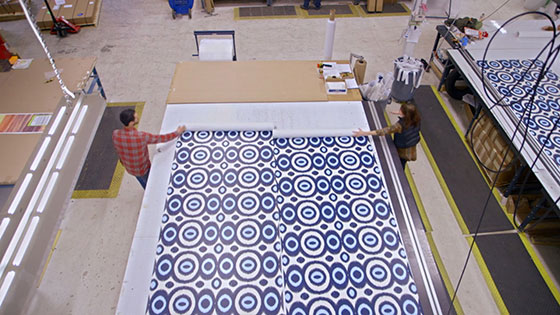Once a print service provider gains accreditation from the Sustainable Green Printing Partnership, the process isn’t over. Certified companies are required to repeat the SGP compliance audit every two years and continuous improvement goals are set annually. So, how do PSPs find new ways to evolve their sustainability plan year after year? One of the early adopters of SGP certification, Designtex, shows how they never stop striving to reduce their footprint.
Designtex’s digital printing facility has been SGP certified since 2009, originally as Portland Color, which was purchased by Designtex in 2011. The company designs and manufactures applied materials for the built environment. All textiles and wallcoverings are printed in-house with a focus on doing so sustainably.
Efforts to be more environmentally responsible started when then Portland Color was moving to a new facility in 2005. With a fresh start in a new location, the owner opted to approach things with an eye toward increased sustainability, says Paul Glynn, former manager of materials and digital technology R&D. [Editor’s note: Glynn held this post at the time of Big Picture’s interview. He has since moved to another company within the graphics industry.]
First seeking out a state of Maine program for going green and then connecting with folks at SGIA who were working on launching SGP, the PSP got involved with the early stages of SGP’s creation and was among the first to be certified. After Portland Color was acquired by Designtex, a Steelcase company with its own rigorous sustainability standards, complementary goals were added.
In addition to SGP-related efforts, Designtex offsets its carbon emissions by supporting carbon reduction projects, such as wind farms, and has SCS Indoor Advantage Gold certification for low emissions from the printing of all digital wallcoverings.
Every textile product sold by Designtex lists the components and calls out environmental aspects so clients can see exactly what they are buying. Glynn says Designtex continues to seek partners in their efforts toward ultimately having “cradle to cradle” products by taking their textile waste, turning it back into yarn, and weaving that into a new printed-textile product.
Advertisement
Last year, Designtex made strides toward a goal of zero production waste. The company now gets paid to return hybrid packaging materials to its vendor for reuse. Another vendor pays for the return of their high-density polyethylene waste. Low-density polyethylene waste goes to a composite decking manufacturer. Organic waste from the facility is composted and then used as soil in the employee garden.
With recent changes in the availability of recycling programs due to China’s near ban on most imported recyclables from the Western world, Glynn says they have needed to employ tenacity and creativity to keep previously recyclable products out of landfills.
Glynn, who serves as chairman of the SGP board of directors, encourages PSPs interested in pursuing SGP certification – or who just want to make some effort toward sustainability – to start small.
“Don’t forget to reach out to suppliers,” he says. “They may already have a sustainability initiative that can help reduce your waste and costs, and if not, they may be willing to collaborate to create one.”


 VEHICLE WRAPS + GRAPHICS3 weeks ago
VEHICLE WRAPS + GRAPHICS3 weeks ago
 Press Releases3 weeks ago
Press Releases3 weeks ago
 Case Studies3 weeks ago
Case Studies3 weeks ago
 Case Studies1 week ago
Case Studies1 week ago
 Benchmarks3 weeks ago
Benchmarks3 weeks ago
 Press Releases2 months ago
Press Releases2 months ago
 Press Releases3 weeks ago
Press Releases3 weeks ago
 Press Releases2 months ago
Press Releases2 months ago












